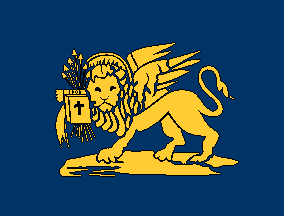
This page is part of © FOTW Flags Of The World website
Ionian islands (Greece, 1800-1864)
Last modified: 2005-05-28 by ivan sache
Keywords: ionian islands | septinsular republic | law | united states of the ionian islands | lion: winged (yellow) | venice | canton: union jack |
Links: FOTW homepage |
search |
disclaimer and copyright |
write us |
mirrors
See also:
Chronology
- Venetian Rule, 1386-1797.
Venice acquired the Ionian Islands off
the western coast of Greece in 1386. Venice was a major naval
power, and the islands were extremely important for control of
access to the Adriatic Sea. After the Treaty of Passarowitz in
1718 all that remained of the Venetian Empire was the Dalmatian
Coast and the Ionian Islands.
- French Rule, 1797-1800. In 1796 Napoléon defeated the
Austrians and Piedmontese in a series of battles, and set up the
Lombard Republic on 16 May 1796. In
March-April 1797 Napoléon crossed the Alps to attack Austria, but
the people of Venetia and Tyrol rose up against the French.
Napoléon was in danger of being cut off, and by the preliminary
Peace of Leoben on 18 April 1797 much Venetian territory
(Dalmatia, Istria, and region between the Oglio and Po) was ceded
to Austria. Austria in return recognised the French puppet
Cisalpine Republic in northern Italy.
But in May 1797 France declared war on what was left of Venice,
occupying it and the Ionian Islands. By the Treaty of Campo Formio
on 17 October 1797 Austria received Dalmatia, Istria and the city
of Venice, but France retained the Ionian Islands.
- Russian Rule, 1800-1807. In December 1798
Russiaallied with
Britain (partly because the new Tsar had
proclaimed himself Grand Master of the Order of St. John), and in
the 1799 War of the Second Coalition, Austrian and Russian forces
captured virtually all of France's conquests in northern Italy of
1796-97. France surrendered the Ionian Islands to Russia, which in
1800 set up the protectorate of the Septinsular Republic.
The seven islands were known to the ancient Greeks as
Heptanesus, and consisted of Corfu, Paxos, Leukas, Ithaca,
Cephalonia, Zante, and Cerigo.
- French Rule, 1807-1815. The War of the Fourth Coalition
saw the disintegration of the Russian army, and by the Treaty of
Tilsit (7-9 July 1807) Russia reluctantly became an ally of the
French and ceded the Ionian Islands to France. After the Austrian
defeat at Wagram, Austria ceded to the French by the Treaty of
Schönbrunn (14 October 1809) all lands beyond the Save River
including Villach, Istria, Hungarian Dalmatia and Ragusa. France
organised these together with the Ionian Islands into the
Illyrian Provinces ruled directly from Paris.
- British Rule, 1815-1864. French defeat in 1814 led to
British occupation of the Ionian Islands. The Congress of Vienna
in June 1815 does not seem to have addressed the question of the
Ionian Islands, but by a separate treaty on 5 November 1815 the
British set up a Protectorate of the Ionian Islands. (And
meanwhile Austria annexed Venice.)
- Greek Rule, 1864-present. On 5 June 1864 Britain ceded
the Ionian Islands to Greece in order to help stabilise the new
Danish royal dynasty there.
T.F. Mills, 8 May 1999
Flag of the Septinsular Republic, 1800-1807
 by António Martins
by António Martins
Quoting Hellenic flags. Insignia-Emblems.
[kok97]:
The first official flag for an independent Greek state after
the fall of Constantinople was the flag of the independent Ionian
Republic. It was introduced in 1800 after a treaty which
proclaimed the Ionian Islands a free and independent state. This
flag remained in use until 1807, when the Ionian Islands were
returned to France.
The State of the Ionian Islands introduced a blue flag with
the winged lion of Saint Marcus holding the Gospel, from which sprung
seven lances symbolising the seven Ionian Islands. In the years of
the Venetian occupation the flag was white bearing the winged lion,
while on the canton there was a depiction of each island's patron
saint, with a cross.
Pascal Vagnat, 9 May 1999
Flags of the United States of the Ionian Islands
 by António Martins
by António Martins
Quoting Hellenic flags. Insignia-Emblems.
[kok97]:
From 1815 to 1864 the Ionian Islands were under the
protection of England and were called the "United States of the Ionian
Islands". The flag with the Venetian Lion was again in use after
1817, with the addition of the British flag on the upper corner.
Pascal Vagnat, 9 May 1999
Extract from A Constitutional Chart of the United States of the
Ionian Islands, as reproduced in an appendix to R.M. Martin's
History of the Colonies of the British Empire (1834).
Ratified by HRH the Prince Regent, in the name and on the behalf
of His Majesty 26th August 1817.
Chapter VII. Miscellaneous.
Section VI. Of the National Colours and Armorial Bearings.
Article 1.
The national commercial flag of the United
States of the Ionian Islands, as directed by the seventh article
of the treaty of Paris, shall be the original flag of these
States, with the addition of the British Union, to be placed in
the upper corner, next to the flag-staff.
Article 2.
On usual days, the British colours shall be
hoisted on all the forts within the United States of the Ionian
Islands, but a standard shall be made, to be hoisted on days of
public rejoicing and festivity, according to the model of the
armorial bearings of the said States.
Article 3.
The arms or armorial bearings of the United
States of the Ionian Islands shall hereafter consist of the
British arms in the centre, surrounded by the arms of each of the
islands composing the said States.
Article 4.
The armorial bearings of each of the
islands shall consist of the individual arms of the islands, and
such emblem, denoting the sovereign protection, as may be deemed
advisable.
David Prothero, 8 May 1999
 by António Martins
by António Martins
